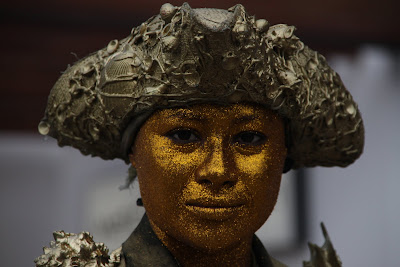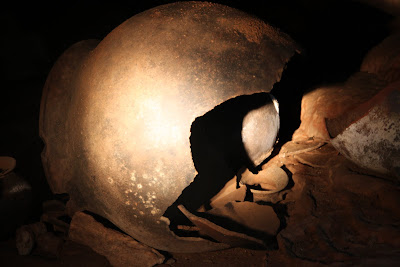Tulum, one of the last cities to be built and inhabited by the Ancient Maya, is about a 45 minute drive from Playa, and is situated along the eastern coast of the Yucatan Peninsula in the Quintana Roo state of Mexico. Tulum is believed to have been dedicated to the planet Venus, hence, the female force of nature. The main shrine at the center of the city, directly facing the gorgeous blue waters of the Caribbean and the sunrise and the sunset, is for Venus, but after Spanish conquest, came to be known as the Pyramid El Castillo (The Castle). Two other significant buildings are the Temple of the Frescoes and the Temple of the Descending God. The former was used as an observatory for tracking the movements of the Sun. A description at the entrance to the ruins reads:
“Religious life and a pilgrimage to the sanctuary, a cultural expression associated with economics, politics, and nature. Mayan gods were present in one or more elements of nature. Some were manifest in the stars or in atmospheric phenomena like rain; others in plants like the ceiba (cotton silk tree) and animals like the jaguar. Each season of the year and each daily activity, such as the harvest, were marked by a ritual dedicated to a deity, aimed at making sure human labor would be rewarded with optimum results. Tulum was a city dedicated to the planet Venus, a deity with a dual nature; that of the morning and the evening star. The descending god symbolized by the setting Sun is closely related to Venus, and so it can be said that the evening star was worshipped at Tulum; thus, the image of this deity is found in the façade of some of the buildings, and its accesses are oriented to face the point where this planet sets. Another important deity was Ek Chuah, the god of trade, to whom tribute was paid in the course of commerce interchanges.”
This description resonates again with Hindu philosophy as well as the many ancient philosophies of the eastern world. It also demonstrates the Maya’s recognition of the sanctity of life, nature, the elements, and the cosmos. Interestingly, the site is run over with iguanas that appear to be guardians of the sacred temples.
 Temple of the Descending God
Temple of the Descending God
 Temple of the Frescoes
Temple of the Frescoes
 Under the watchful gaze of the guardian iguana
Under the watchful gaze of the guardian iguana
 Templo Dios del Viento (Temple of the Wind Gods)
Templo Dios del Viento (Temple of the Wind Gods)
 Temple to Venus, the main shrine
Temple to Venus, the main shrine
Our last days were spent lounging on the stunning beaches of Playa del Carmen, swimming in its crystal and turquoise blue waters, or simply walking along the promenade, lined with restaurants and shops. A variety of street performers entertained passersby, who could rest over a cold beer, refreshing gelato, or very cheap massages. This wouldn’t be considered authentic Mexico, but it was a relaxing way to end the trip before returning to the madness of work!

























